After a brief visit to the archaeological site of Agia Triada, I transferred by car just a couple of kilometres further to the east and reached Kastri Hill and Phaistos which is one of the most important archaeological sites on Crete. There, practically on the south coast of Crete, there are remains of the second largest Minoan palace (after Knossos).
But, first I admired the beauty of the landscapes again. From the parking lot, looking to the north, I could enjoy the view at fields, hills and mountains in the distance. Agia Triada, that I had visited earlier, is situated approximately on the third hill from the left.
 Phaistos: north view from the parking lot
Phaistos: north view from the parking lot
On the opposite side I could see parts of the site (on the left-hand side of the following photo), as well as the beginning of the largest plain on Crete – the Messara Plain. It is around 50 km long in the east-west direction and around 7 km wide in the north-south direction, and starts right here at Phaistos extending further to the east.
 Phaistos: view at the beginning of the Messara Plain
Phaistos: view at the beginning of the Messara Plain
A wide path leads from the parking lot to the entrance into the site. Although I certainly wanted to reach the remains of Phaistos as soon as possible, I did have to stop and briefly deal with bees and flowers, even when the flowers belonged to cacti. One needs to note the pollen that the bee has already collected and that can be seen on its tiny legs.
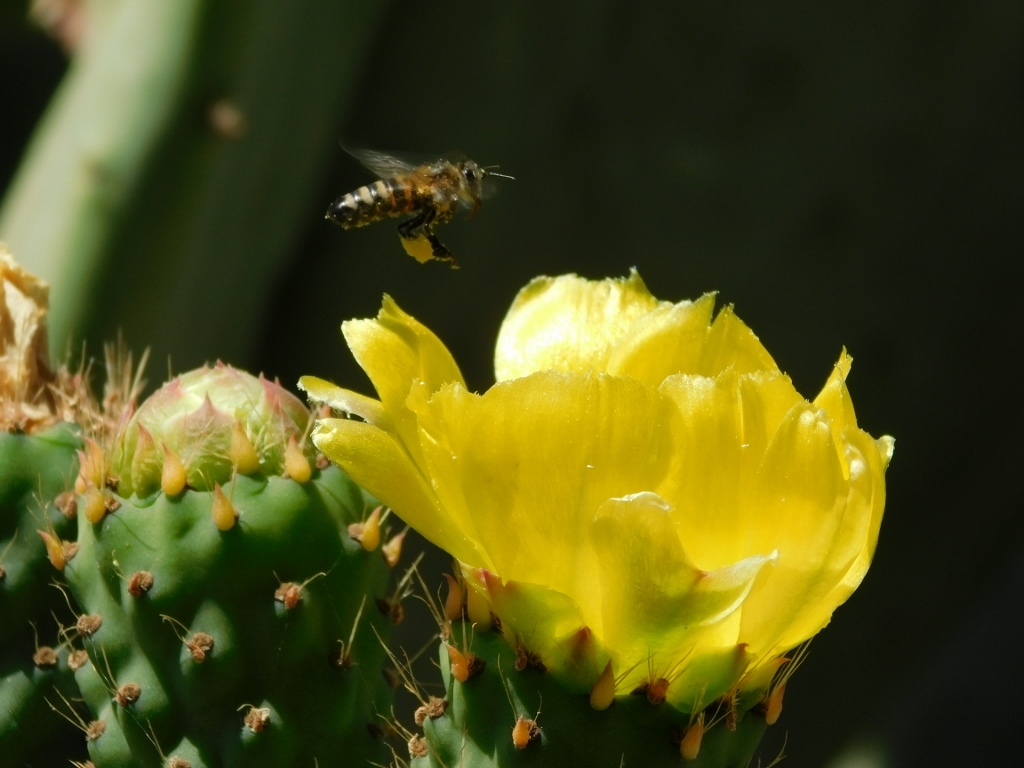 A bee and a cactus flower
A bee and a cactus flower
According to a legend, Phaistos was founded by a brother of King Minos, Rhadamanthys, who, like his sibling, was a son of Zeus and Europa.
This is what the legend says and what the research has shown is that this area was inhabited already during the Neolithic period, in the 5th millennium BCE. The first palace at this site was built around 1900 BCE. This palace, however, was destroyed in an earthquake and a new one was built over the remains of the old one around 1700 BCE. It was used until 1450 BCE when something unclear happened (either an earthquake or interior skirmishes) which destroyed all the palaces except the one in Knossos. It all took place during the Bronze Age and it is important to mention that in fact not much is known about the people that constituted this civilisation that is considered the first civilisation in Europe. Nowadays, they are called the Minoans and the civilisation is called the Minoan one, however, this name after the mythical King Minos was concocted by Sir Arthur Evans who conducted the excavations at the palace of Knossos near Heraklion at the beginning of the 20th century. What these people here called themselves is not known.
The reasons for this are numerous and among others, here is Phaistos, the main one is the lack of artefacts with inscriptions. What was found, in 1908, is the Phaistos Disc. I have already mentioned it and its photo can be seen in part 5 of my Crete travel stories (see: https://www.svudapodji.com/en/crete-5/). It is exhibited at the Heraklion Archaeological Museum where it is said that the disk dates back to the 17th century BCE.
Around 1400 BCE, when Crete was conquered by Mycenaeans or the Achaeans, as Homer collectively calls all (ancient) Greeks, Phaistos was already destroyed and no artefacts from the Mycenaean era have been found here.
By the way, some researchers believe that Phaistos was the home of the famous sage Epimenides who lived around 600 BCE, although it is often said that he was from Knossos. In any case, he is attributed with the famous logical paradox in which he says: “All Cretans are liars.” The logical paradox comes from the fact that he himself was from Crete. Think about it...
After a certain hiatus, the site of Phaistos was re-inhabited in the 8th century BCE and there are remains of structures built during the Hellenistic period (323-67 BCE). Still, Phaistos was finally destroyed in 150 BCE and after that it played no further role in the history of Crete.
Be as it may, the things remained like that until 1853 when, within the scope of a Mediterranean Survey, a British vice-admiral successfully located the potential site where the Minoan Phaistos may be located (at the time, there was a hamlet with 16 houses on the top of this ridge), while the later-date explorations (and the resettlement of the hamlet) helped bring the remains of this ancient town to the light.
Today, when you enter the site, you first come across the Upper Court.
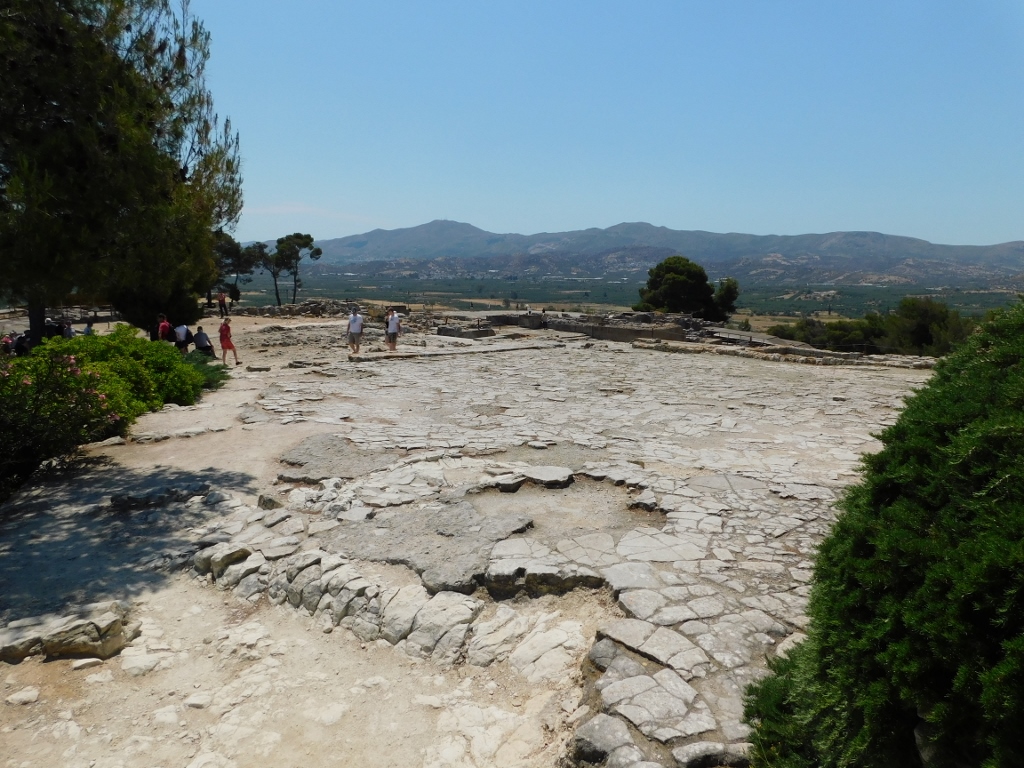 Phaistos: the Upper Court
Phaistos: the Upper Court
It is presumed that the courtyard was used for sacred processions and rituals, as well as a balcony. Namely, from here there is a fine view at the West Court that extends in the south direction, but at a lower level. I went to the end of the Upper Court precisely to make sure about this.
 Phaistos: view from the Upper Court
Phaistos: view from the Upper Court
In the photo above, the West Court is to the right, while to the left there is a wide staircase that leads to the Propylaea, the main and the most impressive entrance into the New Palace (1700-1450 BCE). I first walked to this structure.
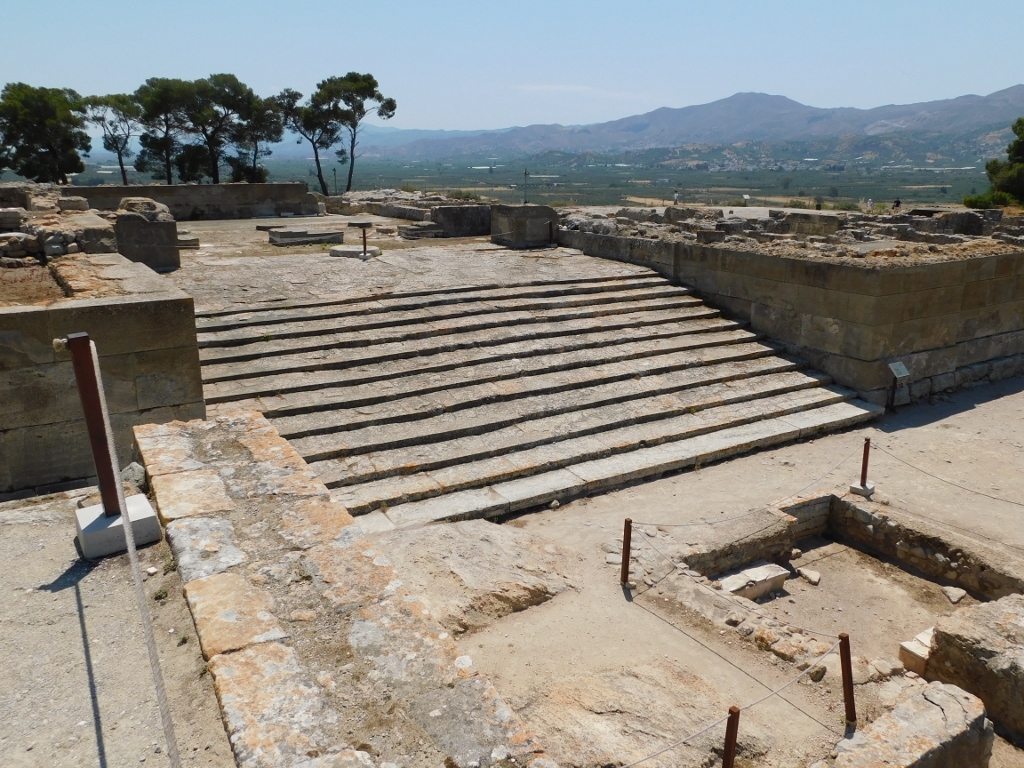 Phaistos: the staircase in front of the Propylaea
Phaistos: the staircase in front of the Propylaea
As far as the impressive Propylaea is concerned, only the remains of the middle column and two flanking pilasters have survived to date, but it needs to be emphasised that this palace, just like all other Minoan palaces, had several storeys.
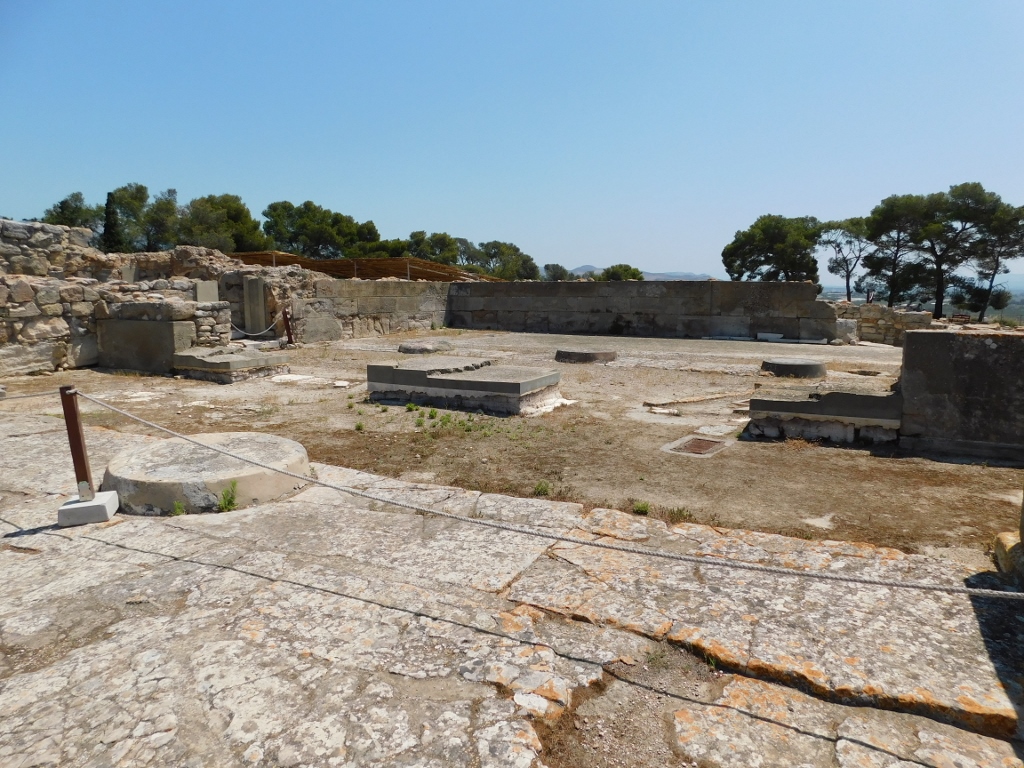 Phaistos: remains of the Propylaea
Phaistos: remains of the Propylaea
This also provided me with a fine view of the part of Phaistos that I had already visited. In the photo below, on the right-hand side and up, there is the platform that constitutes the Upper Court. Also on the right-hand side is the wide staircase that connects the Upper Court and the West Court that is on the left-hand side of the photo. Between the staircase of the Propylaea and the West Court, approximately in the middle of the photo, it is possible to discern the walls of the Tripartite Shrine.
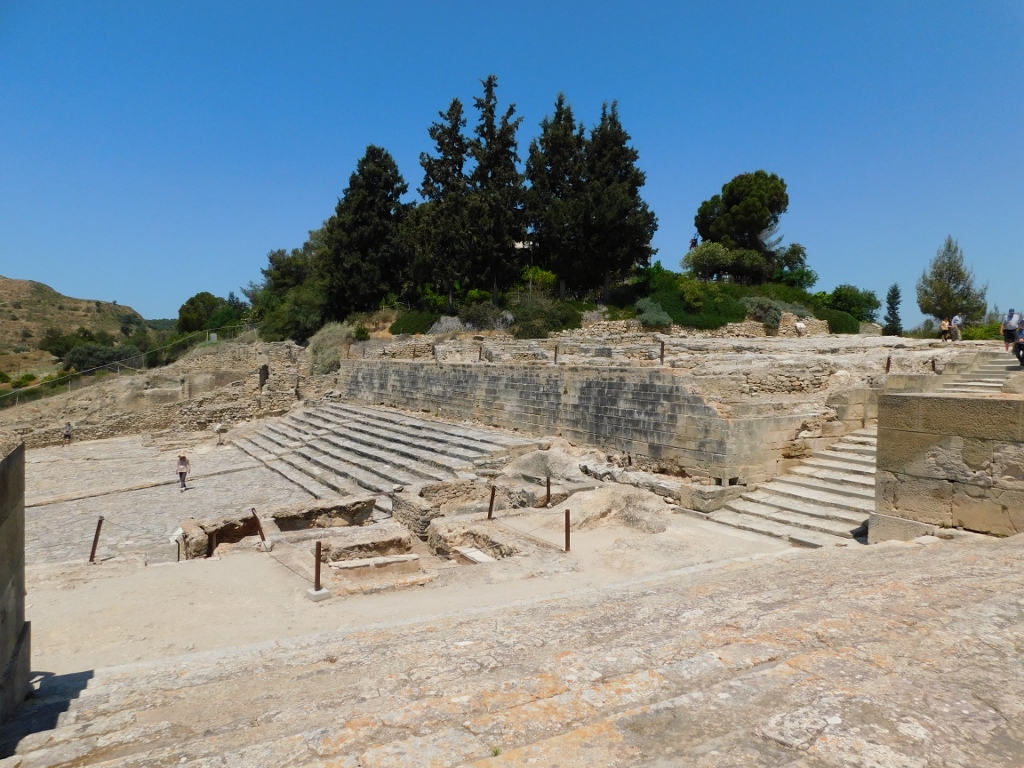 Phaistos: West Court (left) and the Upper Court (right)
Phaistos: West Court (left) and the Upper Court (right)
As for the Tripartite Shrine, it was built between 1900 and 1700 BCE, and it followed the typical tripartite layout of Minoan temples. It was precisely the research and the finds that have undoubtedly shown that this was a temple used for religious rituals.
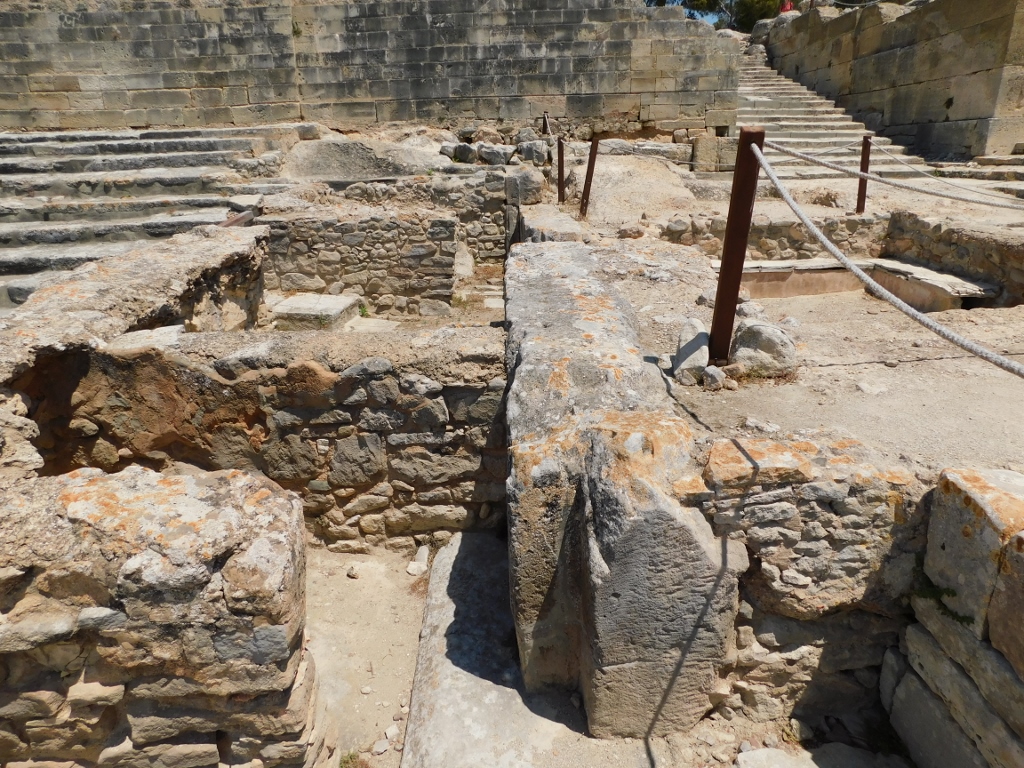 Phaistos: Tripartite Shrine
Phaistos: Tripartite Shrine
By this time I practically reached the West Court and then I just walked along its perimeter, taking photos from different angles. In the following photo it is important to note the Kouloures, large stone pits, located on the south side of the West Court. More about them a little later.
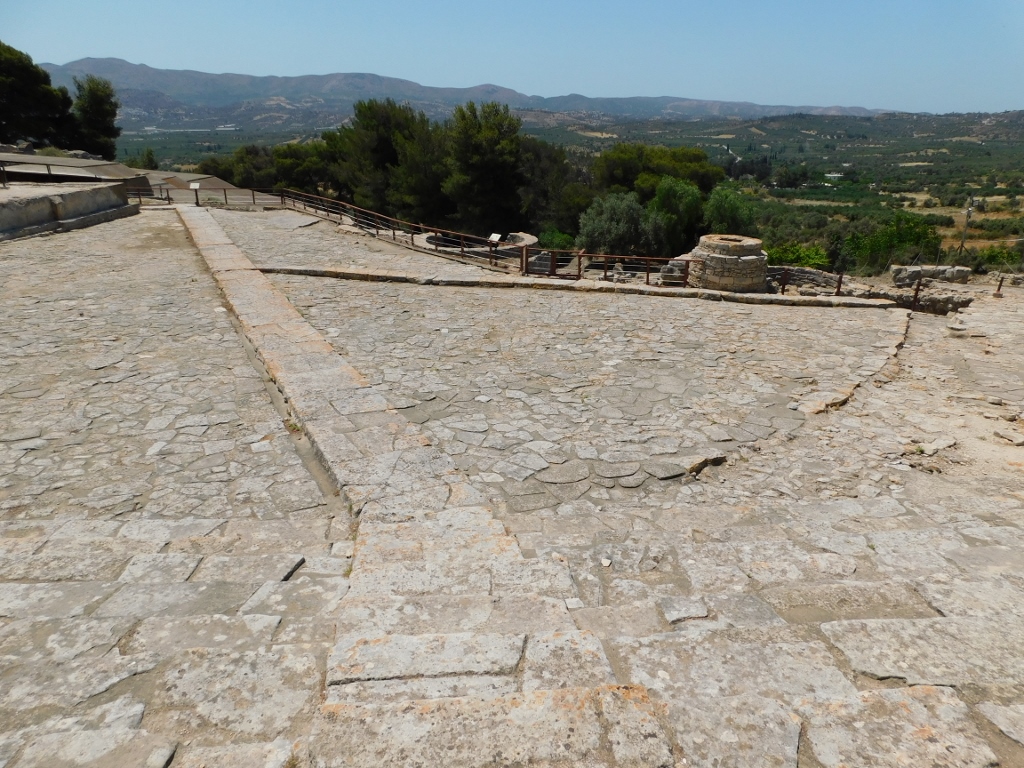 Phaistos: West court (the Kouloures are where the greenery starts)
Phaistos: West court (the Kouloures are where the greenery starts)
As for the West Court that is located in front of the main entrance into the palace, it was formed already during the period of the Old Palace (1900-1700 BCE). On the north side of the square there is a high wall that serves as a support wall for the Upper Court and right below that wall start wide stairs that practically form seats of what the researchers call “the theatre.” During the period of the Minoan civilisation, this meant watching of religious rituals and festivals organised in this place.
And yet, almost every time I get to a theatre or a “theatre” that has anything to do with Ancient Greece, I inevitably remember the beginning of “The Iliad” by Homer. Because where there are Ancient Greeks or the Achaeans, as Homer used to call them, there are the Mycenaeans and their mythological King Agamemnon, and where he is there is his brother, the King of Sparta, Menelaus, and his sister-in-law, Helen (later Helen of Troy), and where they all are, there is the Trojan War.
Well, now. The researchers believe that the Trojan War took place in the 13th or the 12th century BCE, which means when Phaistos already did not function as a palace, a city or a state. This would make my association with “The Iliad” a complete miss. And yet, Homer does mention ships from Crete, including also ships from Phaistos! In other words, the researchers should deal with this subject in more detail and more carefully, while for me this was not a TOTAL blunder.
The other thing is that for an absolutely unclear reason, even today, I remember the beginning of “The Iliad” that I learned by heart for my Serbian language (and (general) literature) in the first grade of the secondary school, which was over 40 years ago!!! Why and how? No idea. I did not care for “The Iliad” at all and I did not even understand much of it on account of the archaic language, but the fact is that I remember that beginning.
And so, whenever I find myself in an ancient Greek theatre, including the one here, I am overwhelmed by the desire to treat myself to the verses of the good, old Homer. Have a look and listen:
I did not dazzle as an actress declaiming ancient verses, but that is beside the point. The point is to enjoy and have fun at every given moment.
And as for the West Court, there is also a visible elevated Processional Causeway that extends along the steps up the “seats” of the theatre.
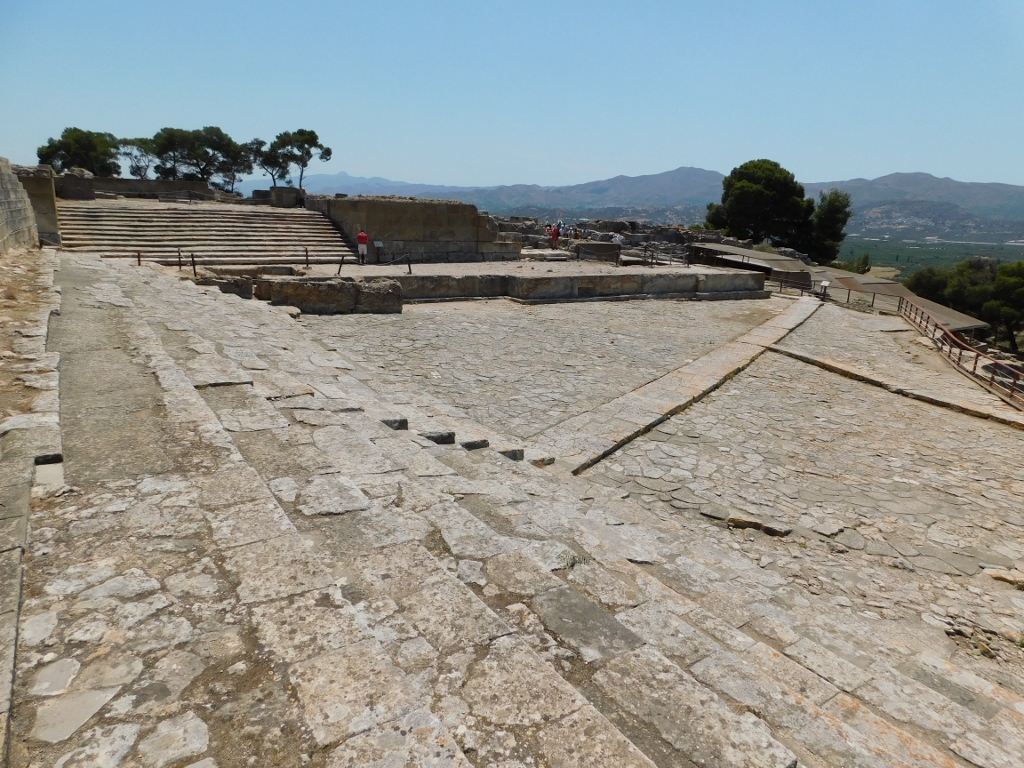 Phaistos: West court
Phaistos: West court
Now I made a circle around the West Court in order for all these elements to be seen better.
 Phaistos: West court
Phaistos: West court
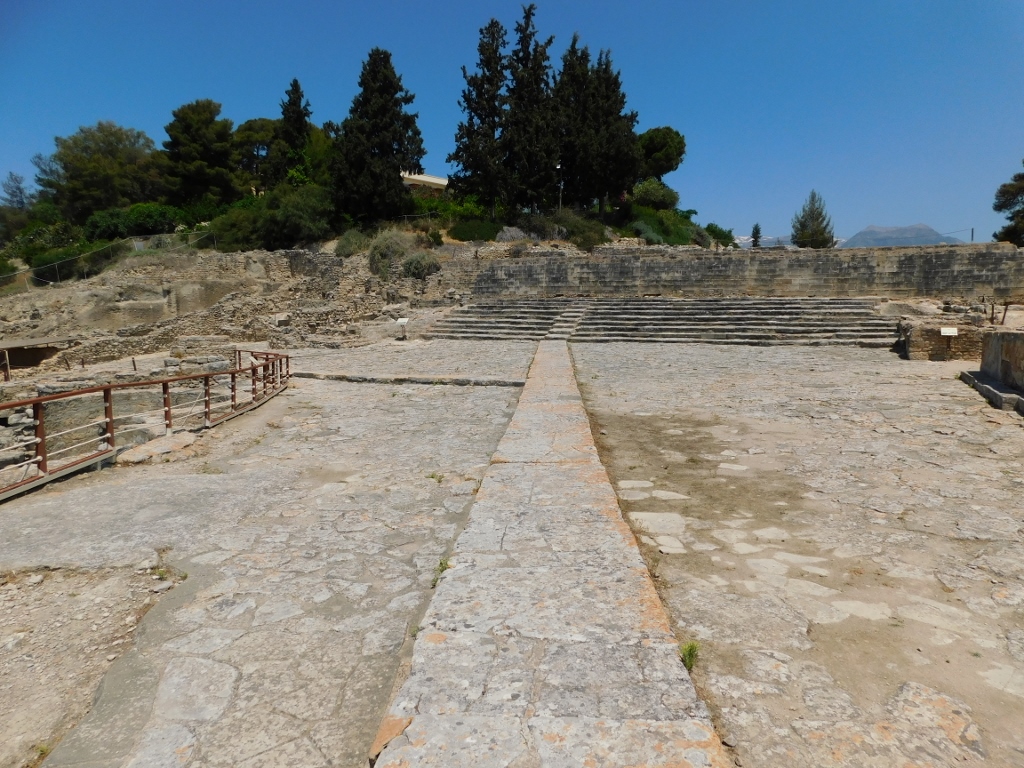 Phaistos: West court
Phaistos: West court
And then I turned around in order to have a better view at the Kouloures. Here, it is possible to see the remains of four round stone-walled pits that belonged to the Old Palace complex. Their actual function remains unclear, but it is presumed that they were used either for depositing offerings from the shrines or as granaries.
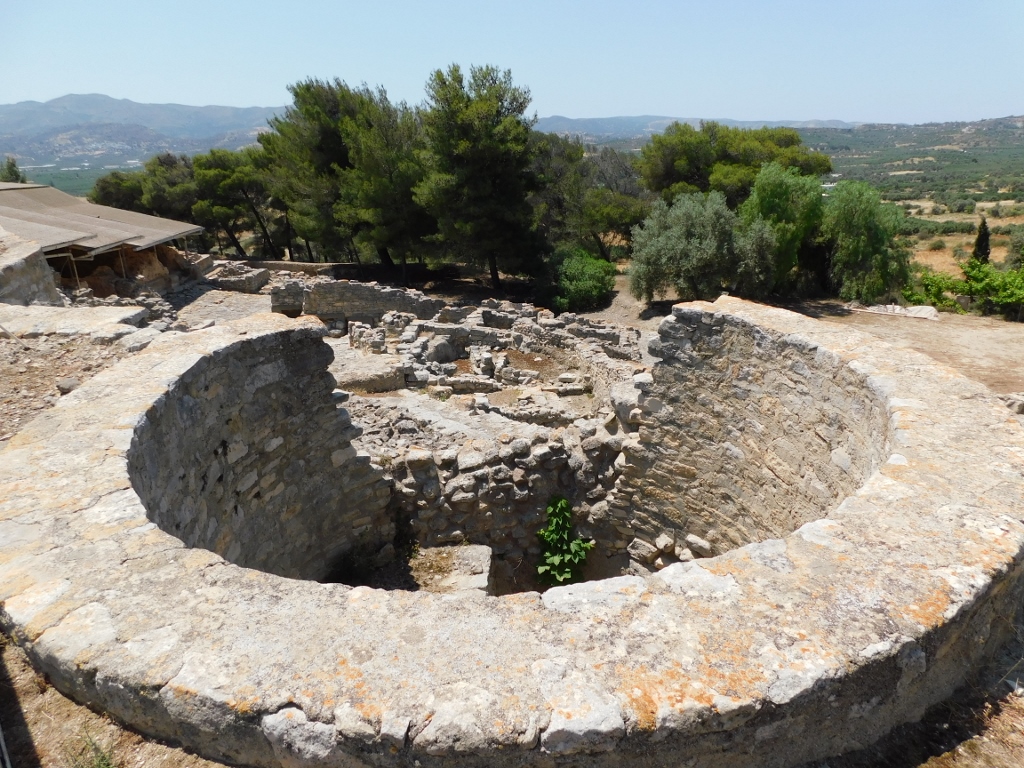 Phaistos: one of the Kouloures
Phaistos: one of the Kouloures
On the east side of the West Court, there are remains of the West Facade of the Old Palace (1900-1700 BCE), although the main facade of the New Palace (1700-1450 BCE) also faced the West Court, but it was positioned higher and further back.
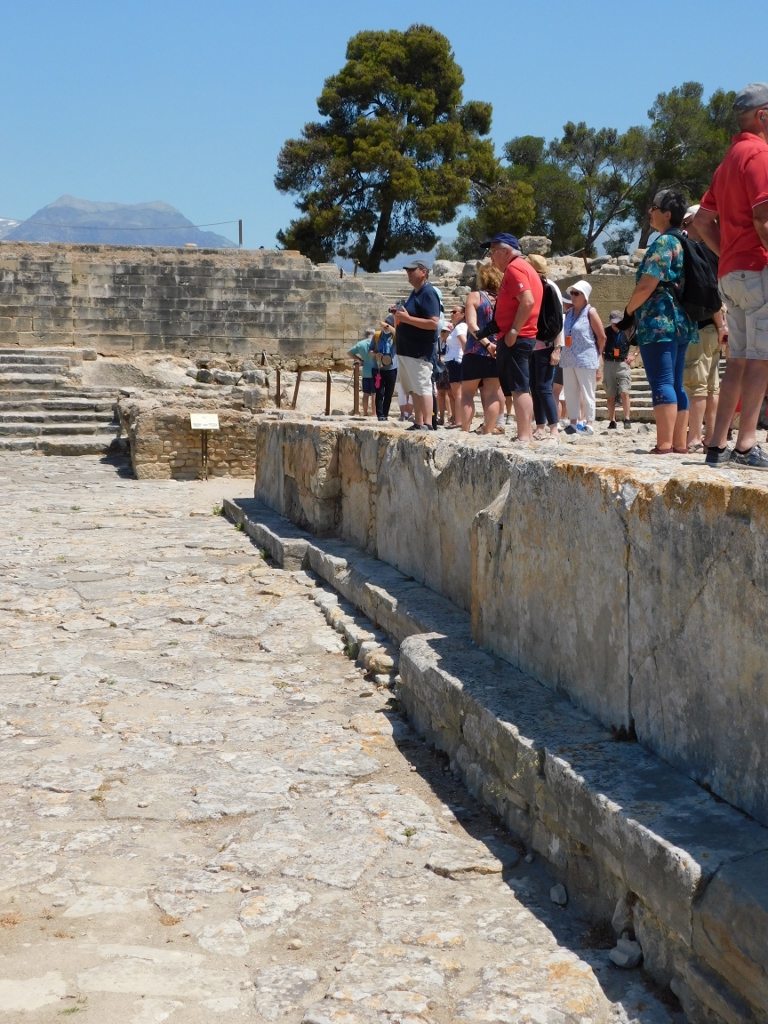 Phaistos: the West Facade
Phaistos: the West Facade
On the south side of the West Court, there are remains of the Old Palace, but the access to that section was for some reason closed off on this day.
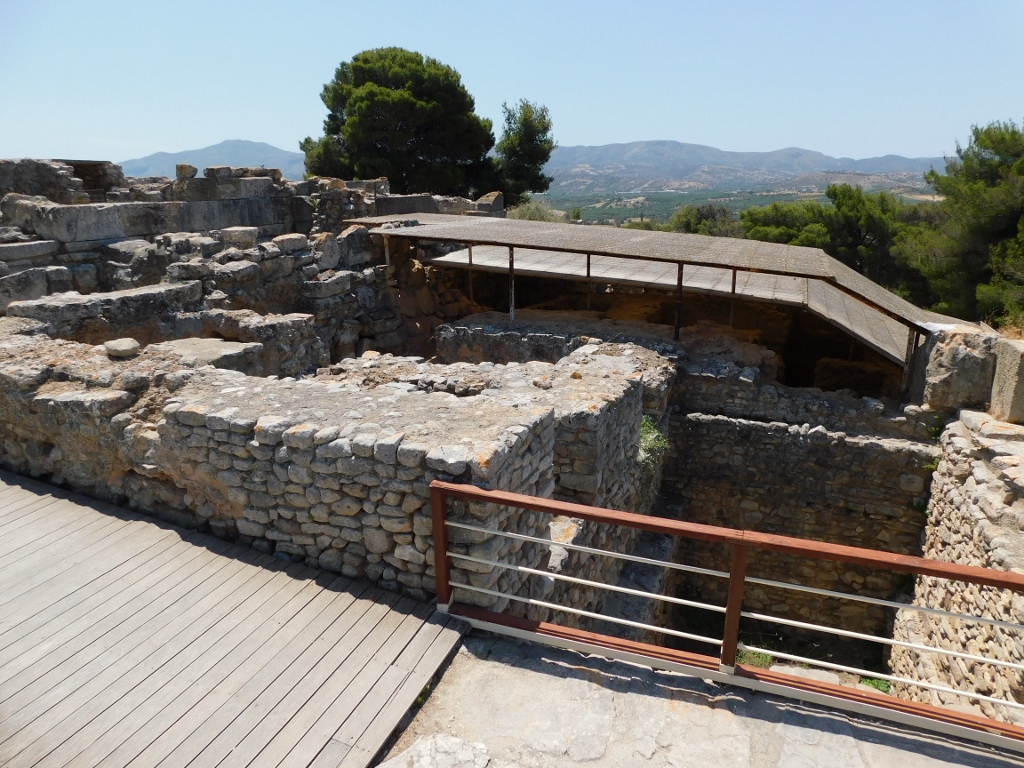 Phaistos: parts of the site south of the West Court
Phaistos: parts of the site south of the West Court
That’s why I went up to the level supported by the remains of the West Facade and this is where one enters a part of the palace that served for the storing of olive oil, wine and wheat, but it also seems that this was where different workshops were located. That section is called the West Magazines.
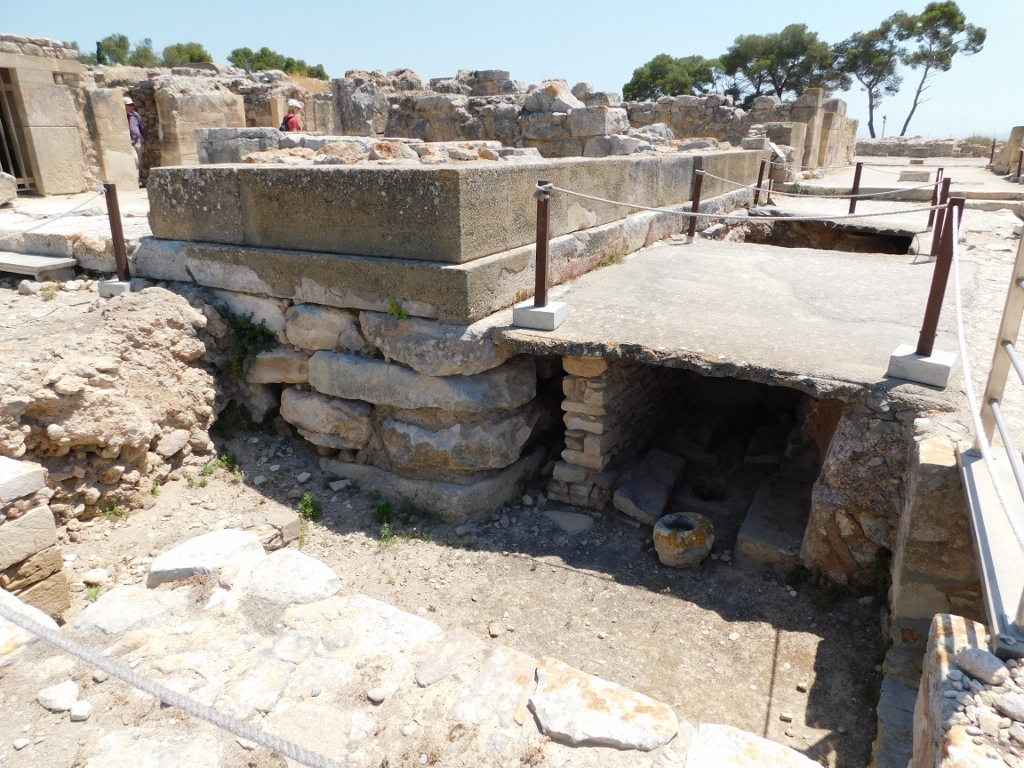 Phaistos: store rooms
Phaistos: store rooms
In some of these rooms, it is possible to see huge pithoi.
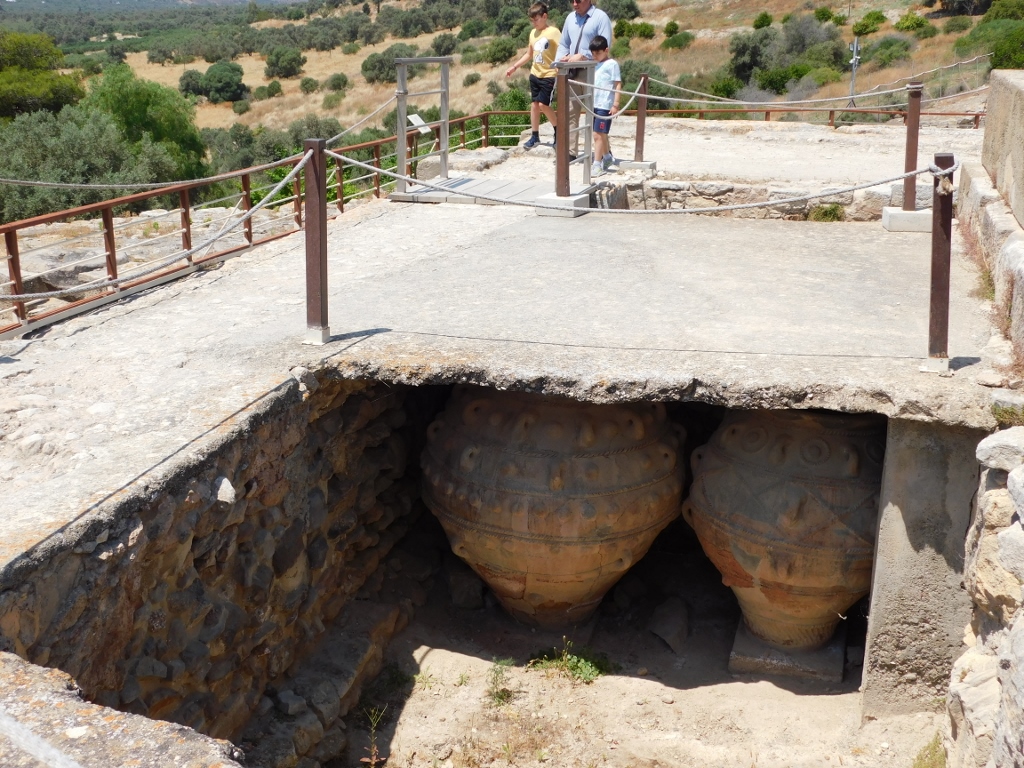 Phaistos: a store room with pithoi
Phaistos: a store room with pithoi
I returned towards the north part of the magazines and there it is possible to see a corridor with rooms on both sides that were used for storing food.
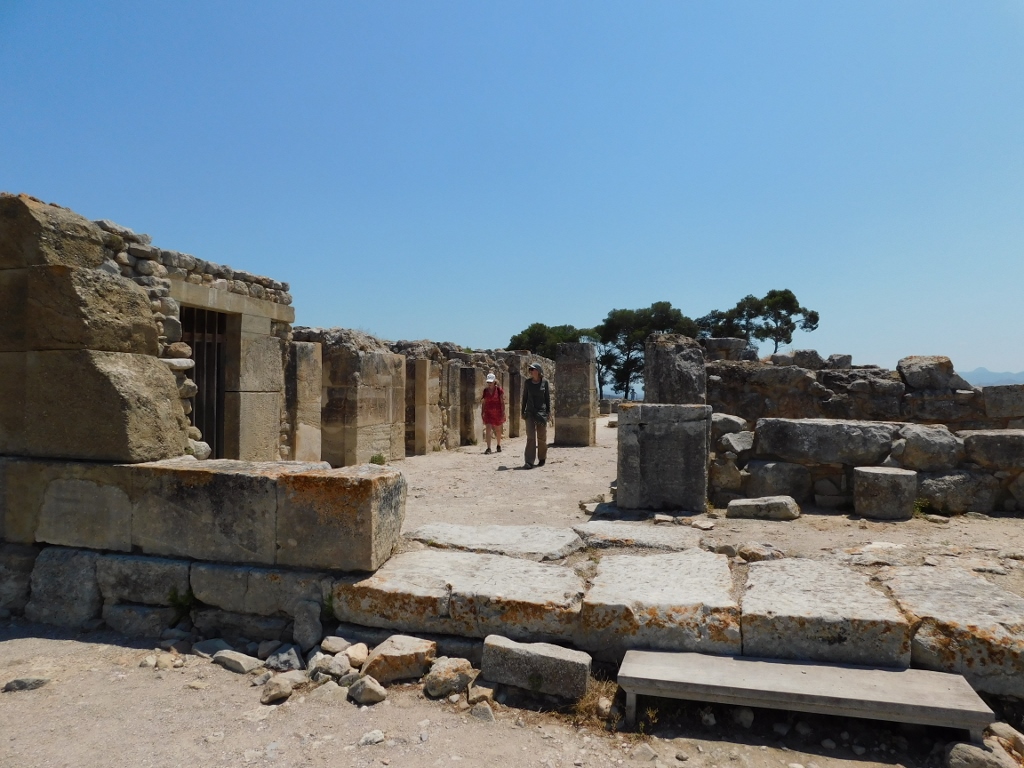 Phaistos: store rooms
Phaistos: store rooms
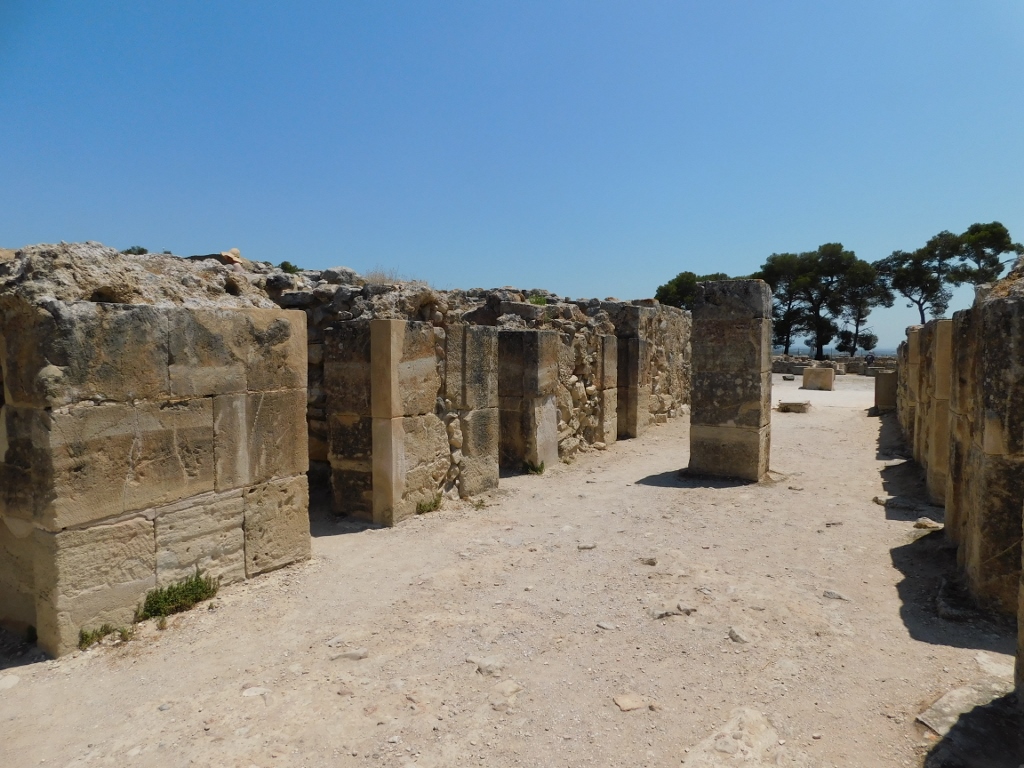 Phaistos: store rooms
Phaistos: store rooms
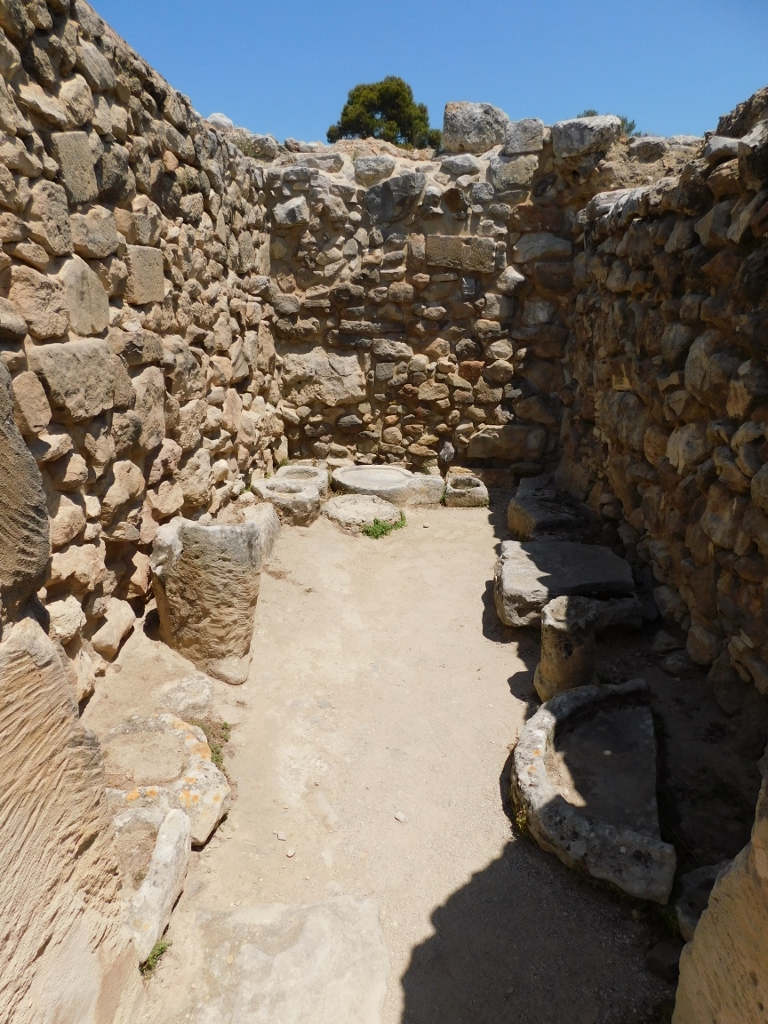 Phaistos: a store room
Phaistos: a store room
Beside one of the rooms, I noticed an interesting sign engraved in one of the flanking stones. I have no idea about its origin or the meaning, but I did find it interesting.
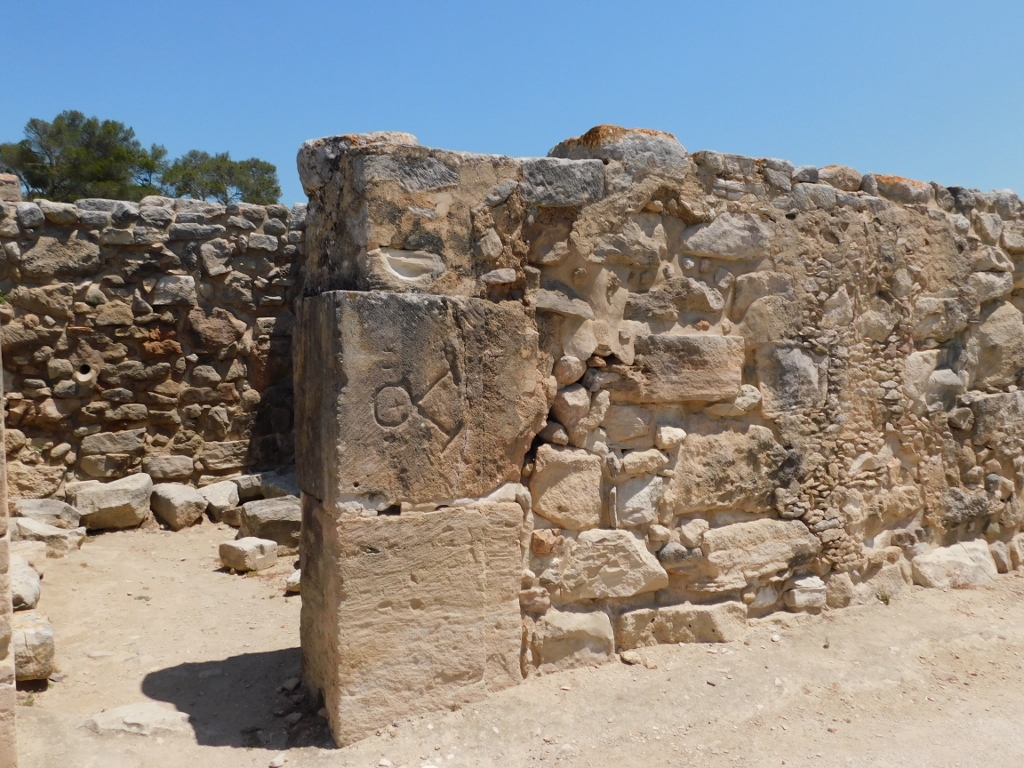 Phaistos: the West Magazines, a detail
Phaistos: the West Magazines, a detail
From the West Magazines, one moves on to a hall with columns from which it is possible to access a part of the store rooms, but which was also further opened on the east side towards the Central Court.
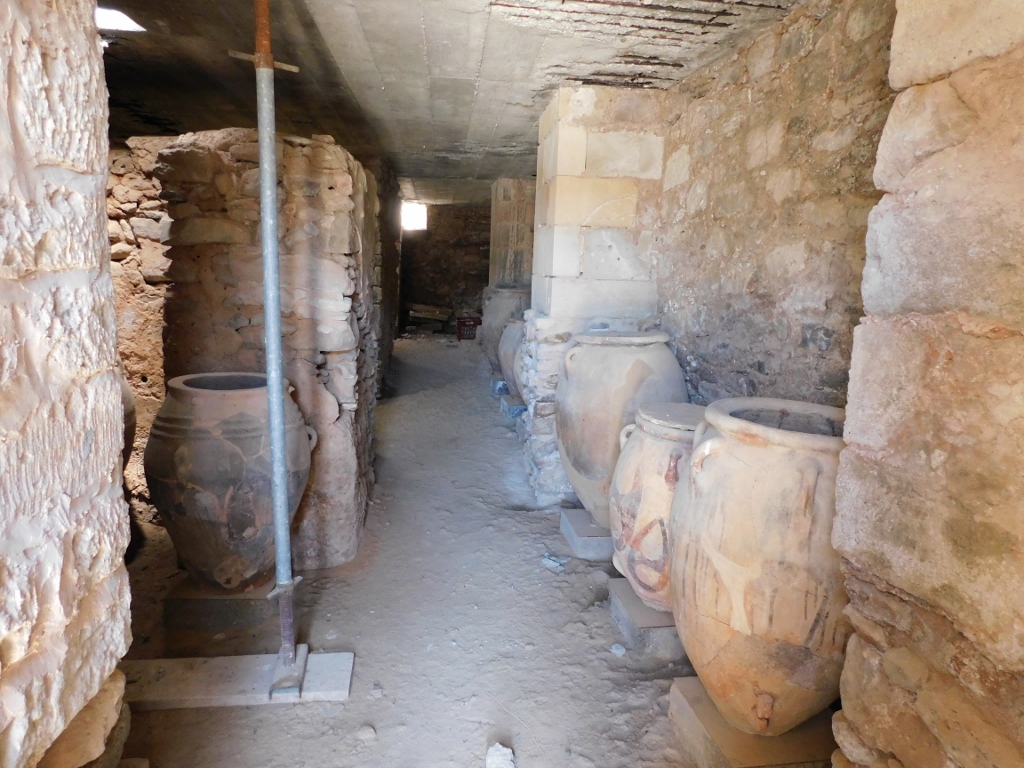 Phaistos: the West Magazines, a detail
Phaistos: the West Magazines, a detail
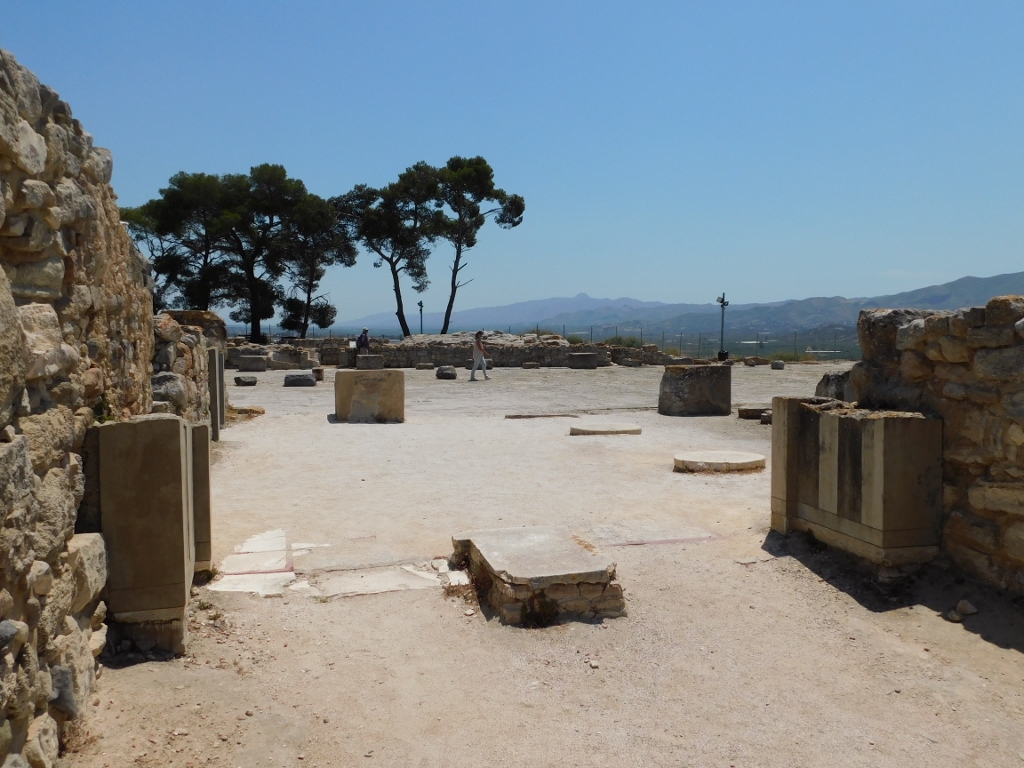 Phaistos: hall with columns
Phaistos: hall with columns
Before dealing with the Central Court, here is the view at the West Magazines, the hall with columns, as well as a direct passage through the south part of the magazines that were here practically located in the “basement.”
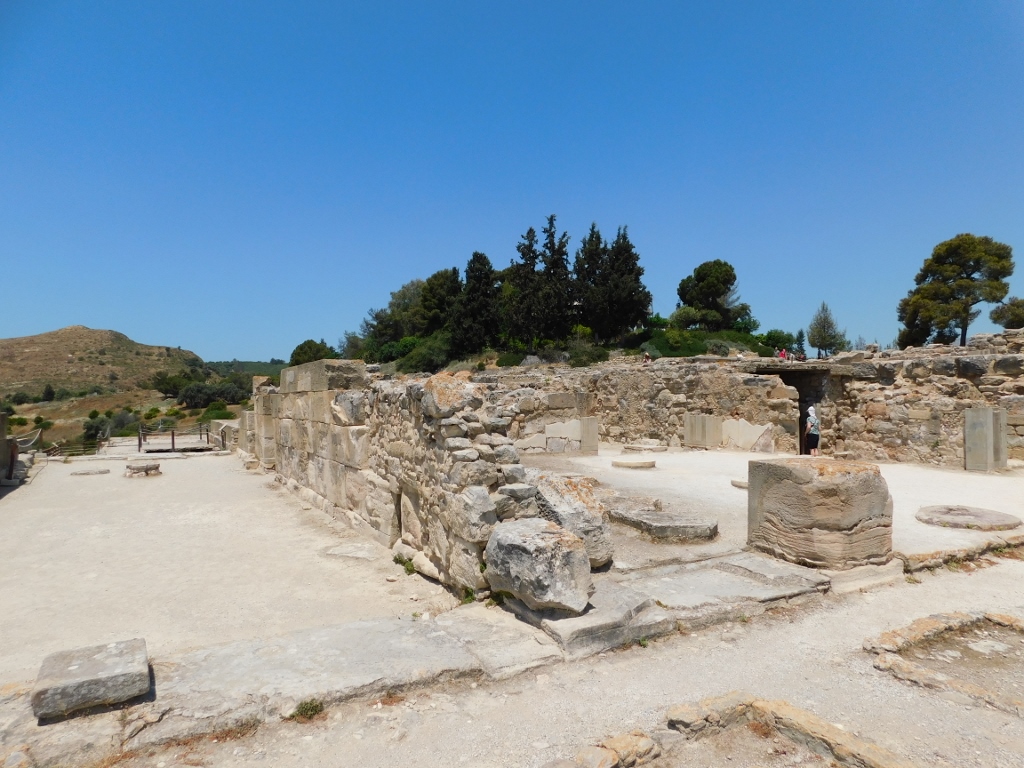 Phaistos: corridor from the direction of the West Court (left), the hall with columns is to the right
Phaistos: corridor from the direction of the West Court (left), the hall with columns is to the right
South of the West Magazines, there are remains of the Shrines of the West Wing that were a part of the New Palace.
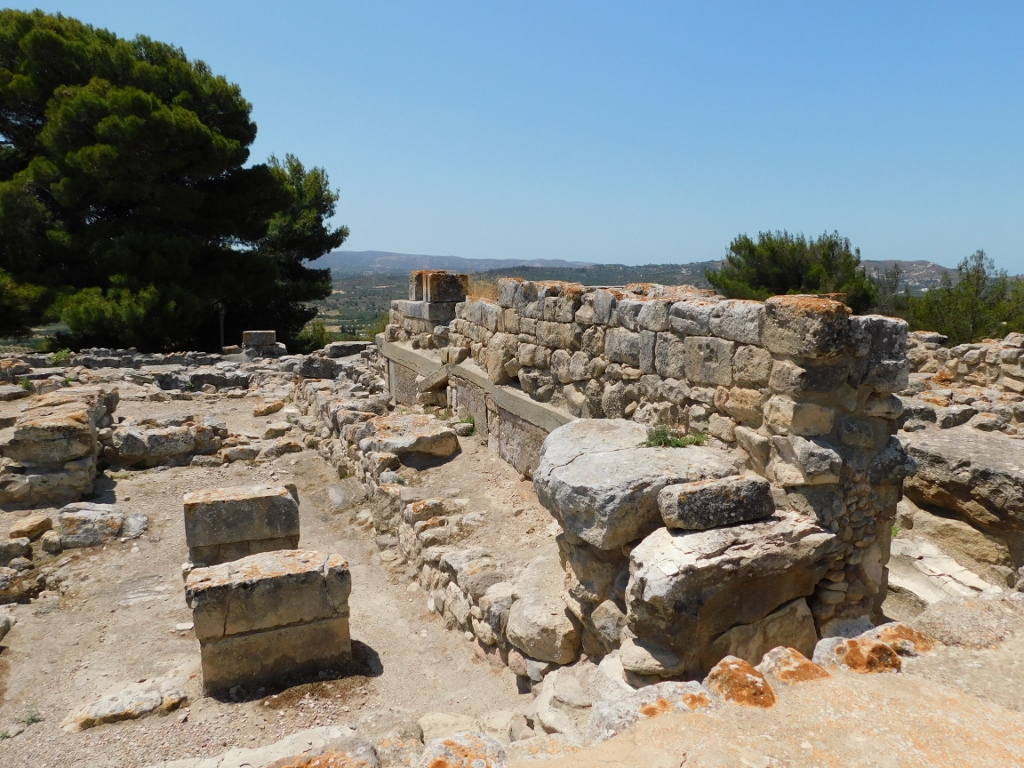 Phaistos: pillar crypt, a part of the Shrines of the West Wing
Phaistos: pillar crypt, a part of the Shrines of the West Wing
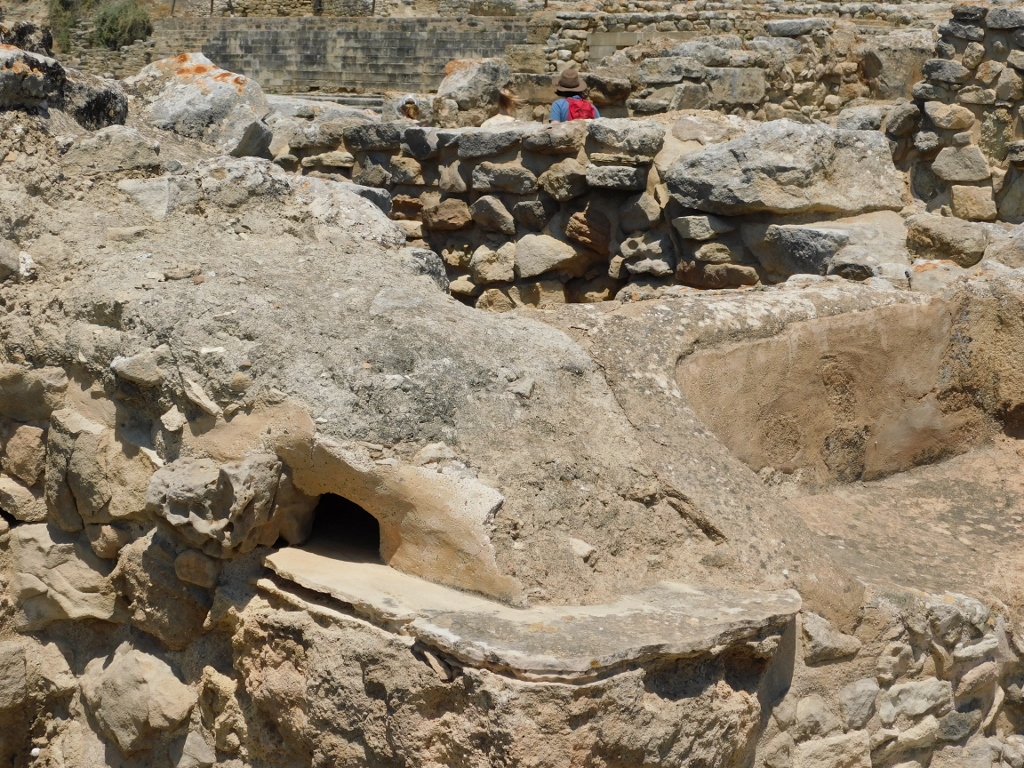 Phaistos: Shrines of the West Wing, a detail
Phaistos: Shrines of the West Wing, a detail
And as for the Central Court, like in the other Minoan palaces, here too it constituted the central architectural element with different palace wings distributed around it. This was the place where the economic, social and religious activities of the palace used to be organised, while the residents could watch this from the windows and balconies, bearing in mind that the Minoan palaces incorporated buildings consisting of several floors. Nowadays, it all looks quite different, there are no surrounding buildings, but the spacious courtyard is here.
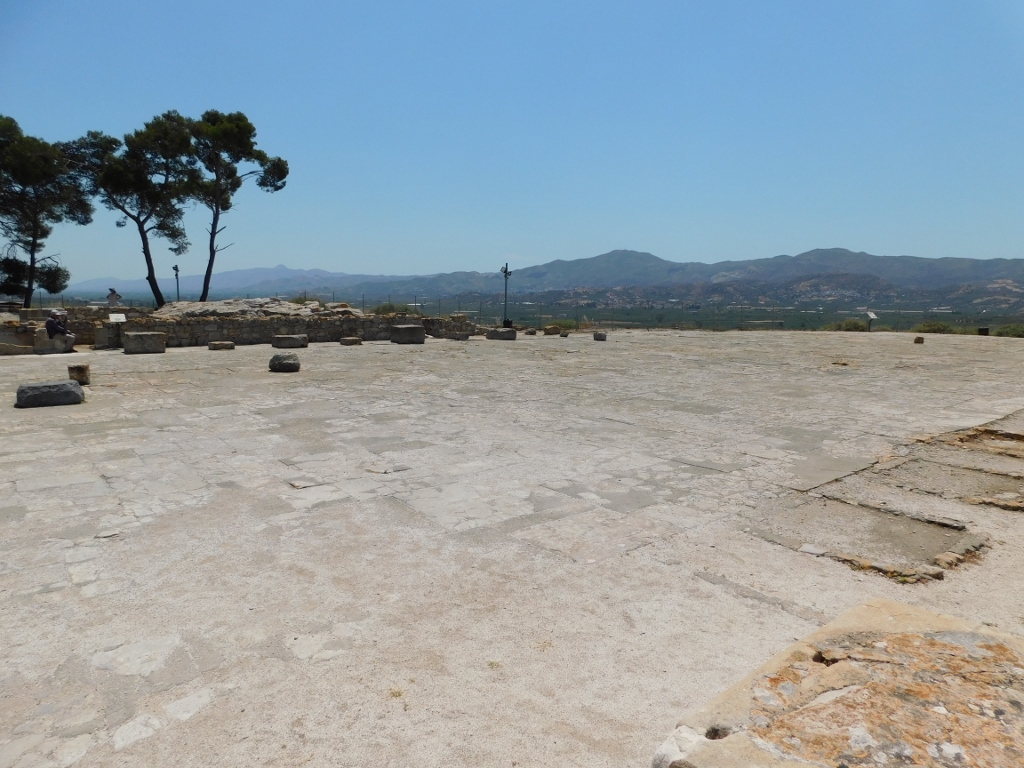 Phaistos: Central Court
Phaistos: Central Court
The Central Court was made already during the period of the Old Palace, but with certain alterations it was used as a part of the New Palace as well. The court has a rectangular shape and along its longer sides there used to be colonnades.
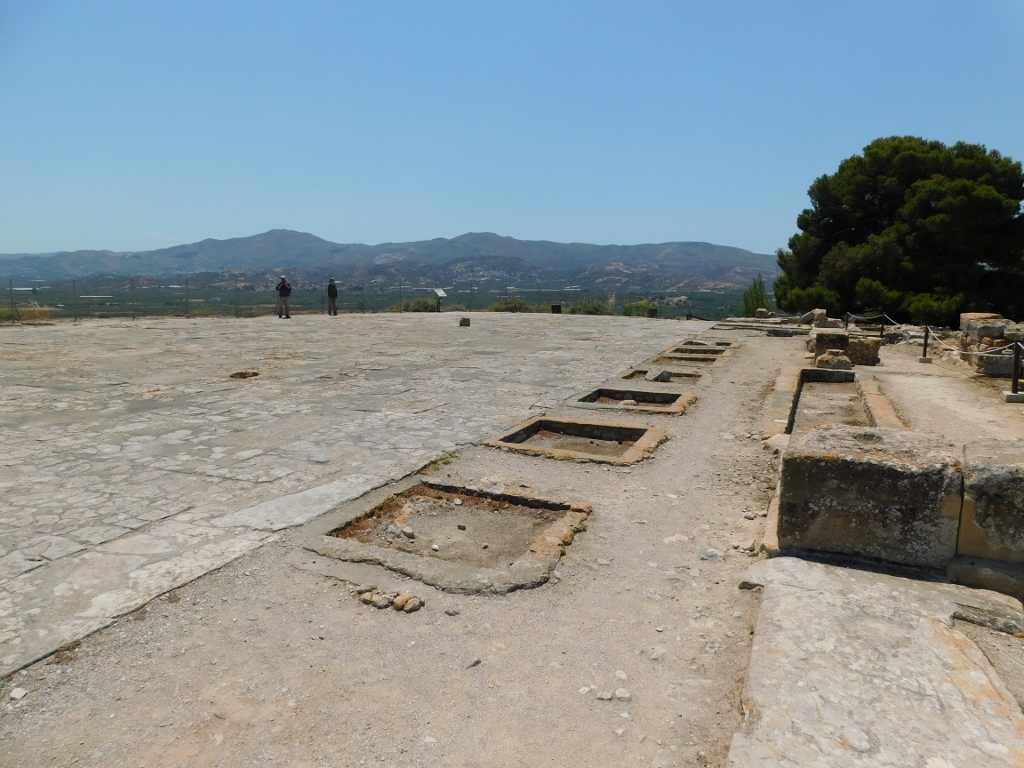 Phaistos: Central Court
Phaistos: Central Court
First I went to the end of the court from where there is a stunning view at the vast Messara Plain where olives, grapes and various other agricultural drops are cultivated.
 View at the Messara Plain from the Central Court in Phaistos
View at the Messara Plain from the Central Court in Phaistos
Having enjoyed this splendid view for a while, I refocused on the remains of the palace in Phaistos and again I had a look at the Central Court, but in the direction of the rest of the palace.
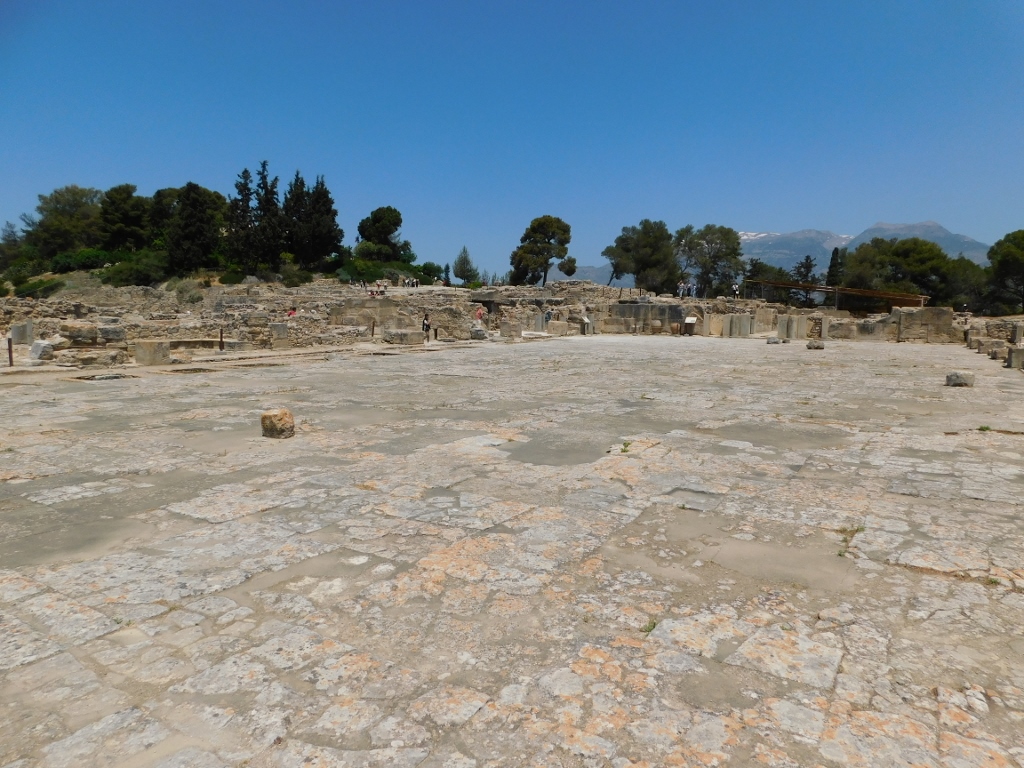 Phaistos: Central Court
Phaistos: Central Court
In the north section of the court there used to be an impressive gate (there are only its remains nowadays) and a corridor leading to the North Wing with the “Royal Apartments.” Along the corridor there is a visible water drainage canal.
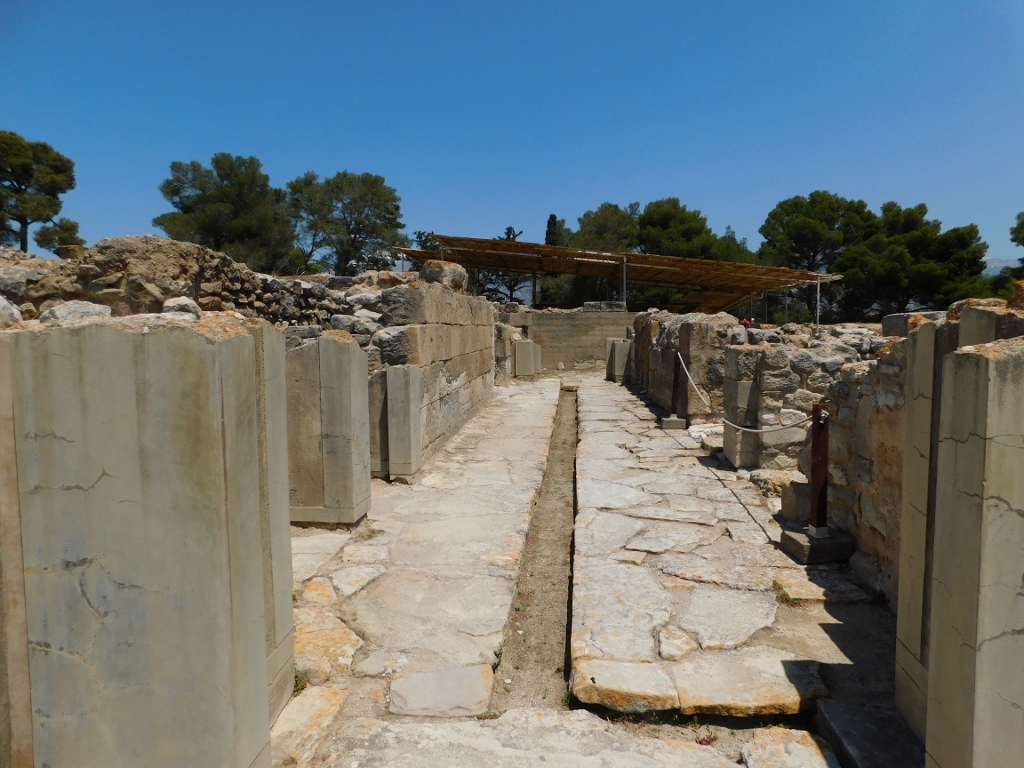 Phaistos: corridor leading to the North Wing
Phaistos: corridor leading to the North Wing
I went along this “corridor” only for a very short while, since a couple of metres farther, on the left-hand side, there are steps that I took in order to have an even better view at the Central Court.
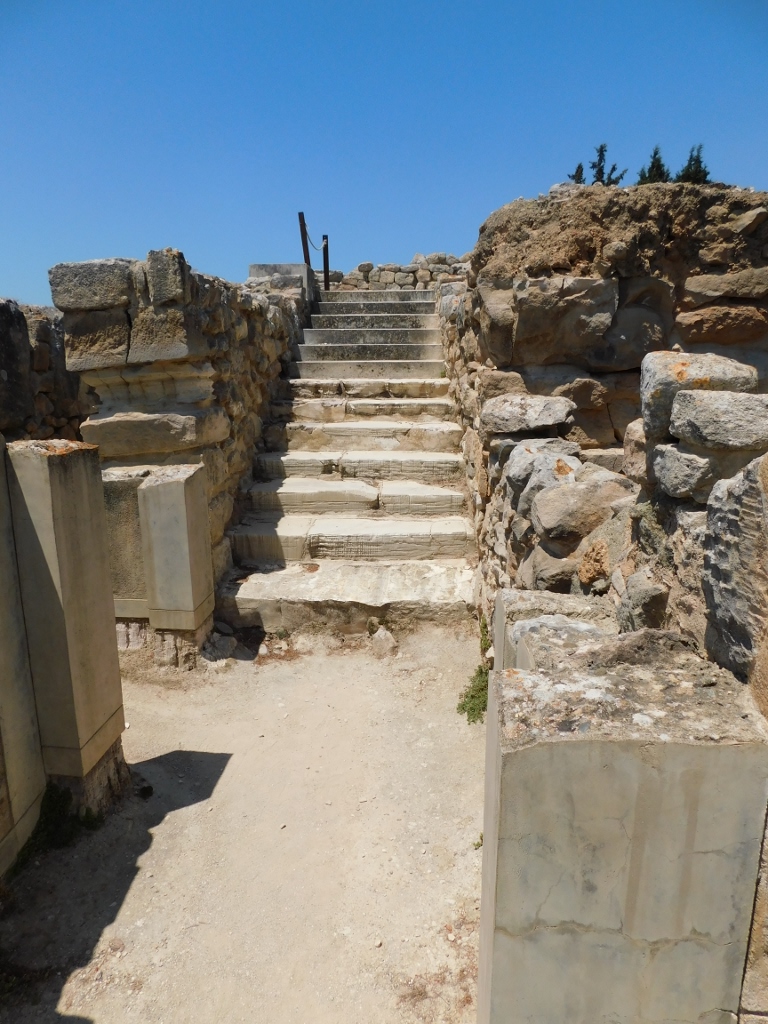 Phaistos: a detail
Phaistos: a detail
 Phaistos: Central Court
Phaistos: Central Court
Still, I did not proceed to the North Wing, choosing rather to go first to the East Wing complex. There are structures that used to be a part of the New Palace there facing the Central Court. Since they constitute a miniature version of the “Royal Apartments,” the researchers have concluded that these must have been premises for a young prince.
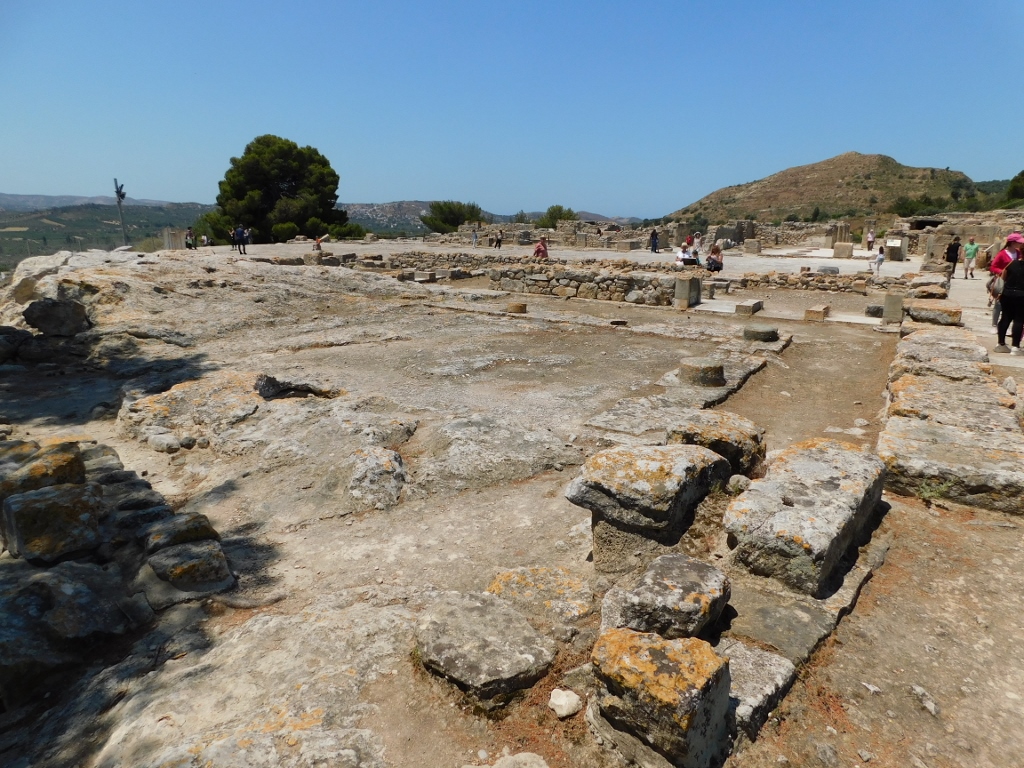 Phaistos: a part of the East Wing
Phaistos: a part of the East Wing
Further on, towards the northeast part of the site, there are remains of rooms believed to be the workshops that were an integral part of the palace. I did not deal much with this section and now I headed back again towards the North Wing with the “Royal Apartments.”
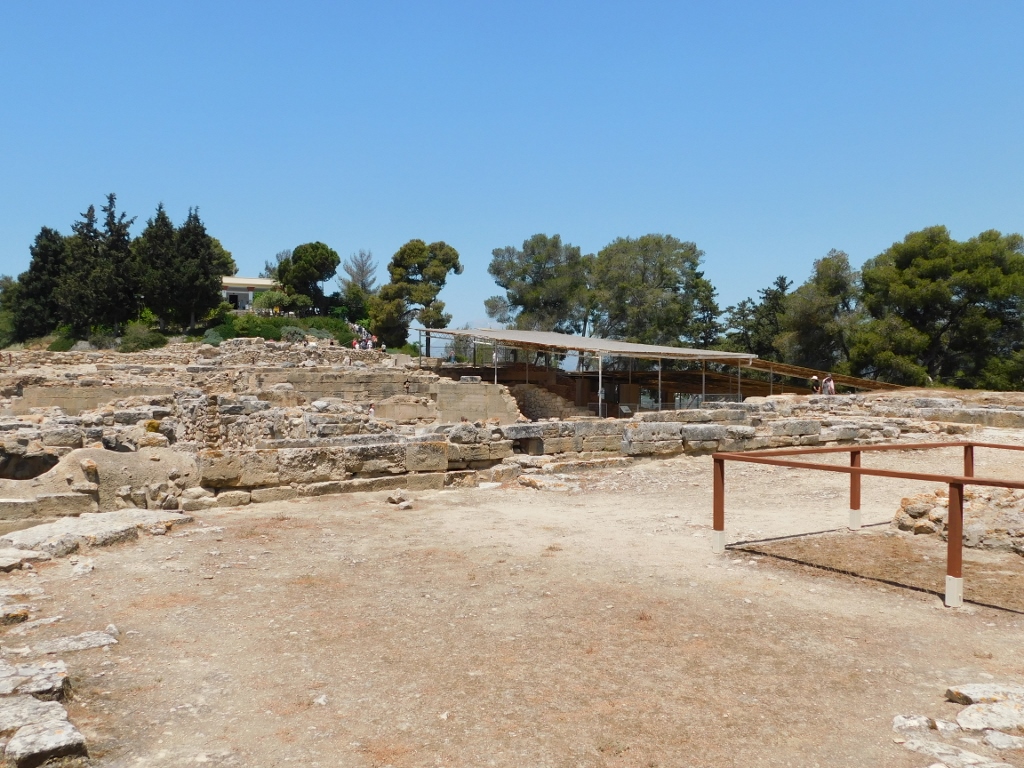 Phaistos: view at the North Wing and the “Royal Apartments” (the canopied part)
Phaistos: view at the North Wing and the “Royal Apartments” (the canopied part)
First I came to a small courtyard that used to connect the Royal Apartments and the Central Court via the drainage canal corridor.
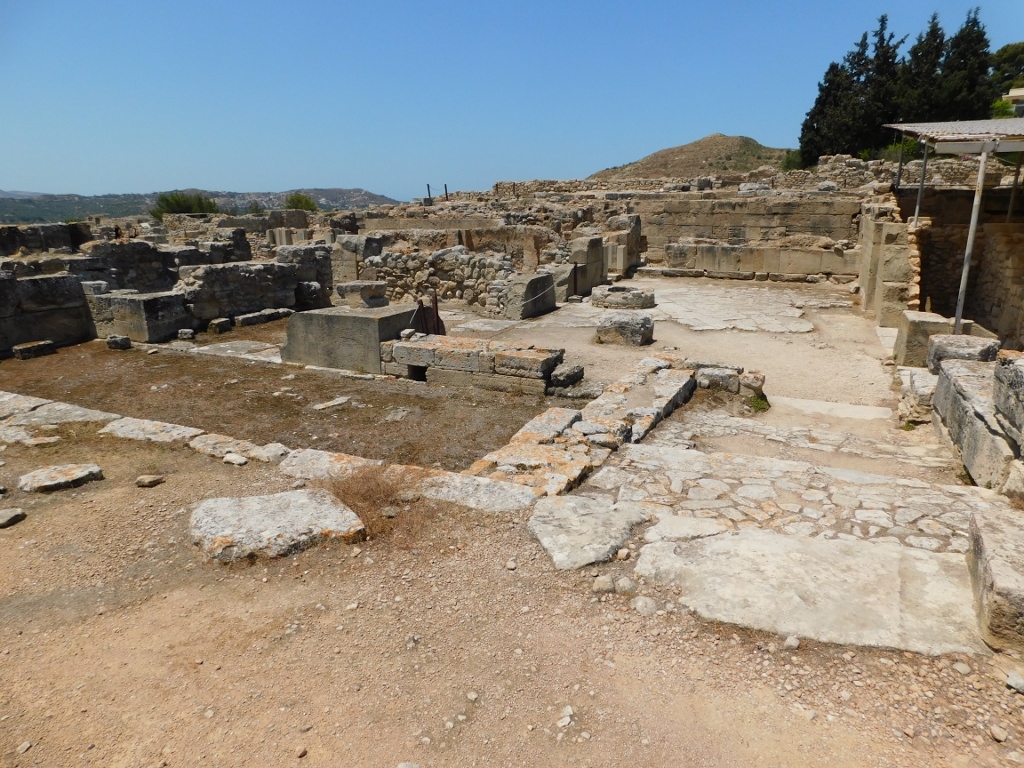 Phaistos: smaller courtyard contains a circular form made of stone
Phaistos: smaller courtyard contains a circular form made of stone
Now came the time for the “Royal Apartments.”
The “Royal Apartments” is a term introduced by Arthur Evans when he excavated in Knossos and so the term spread to the other Minoan palaces as well. These were unquestionably parts of the palaces that were, judging by the architectural features and elements, used by the rulers and thus the relevant terminology simply stuck.
First I came to the Queen’s Megaron. This is a nice, large hall with a double colonnade and it is also possible to see benches that go along the walls.
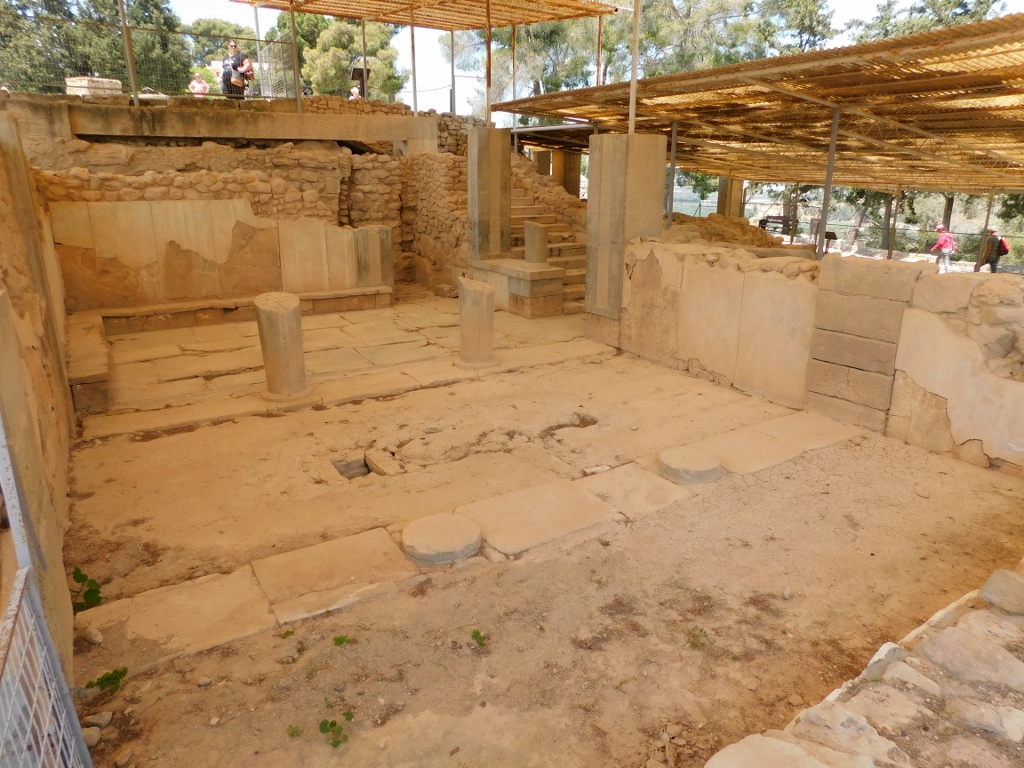 Phaistos: the Queen’s Megaron
Phaistos: the Queen’s Megaron
North of this room there is a corridor and steps leading to the upper floor and further towards the north there is the King’s Megaron, a large room with special stone partitions.
 Phaistos: the Queen’s and the King’s Megarons
Phaistos: the Queen’s and the King’s Megarons
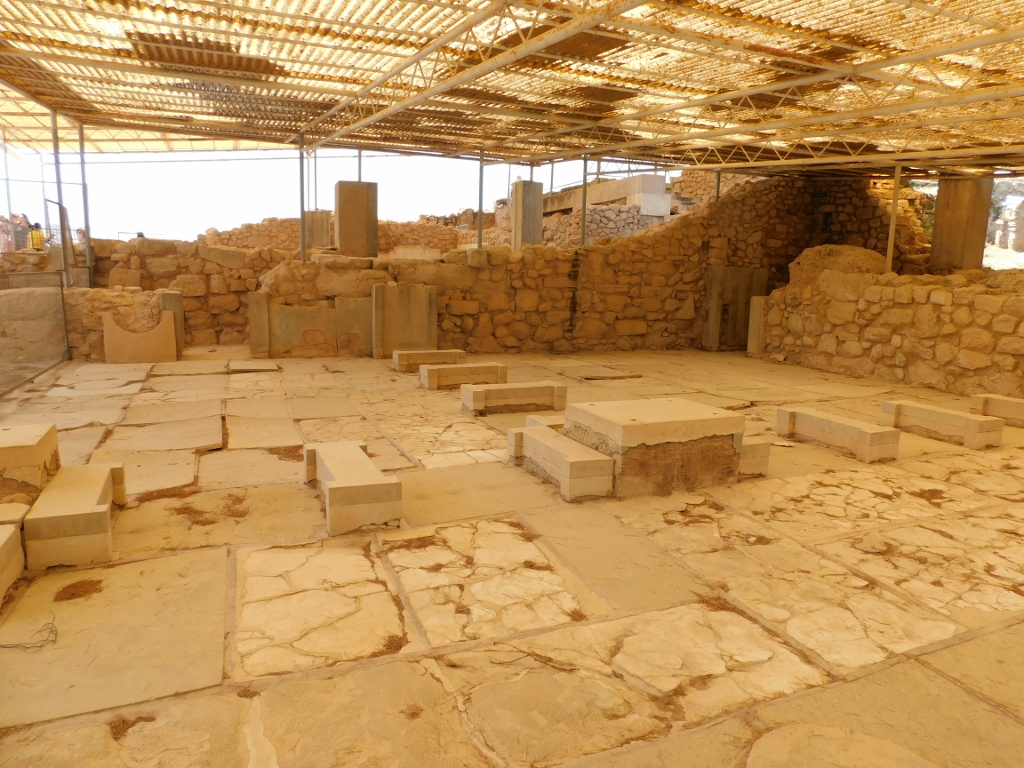 Phaistos: the King’s Megaron
Phaistos: the King’s Megaron
West of the King’s Megaron, there is a Lustral Basin which is believed to be the best preserved lustral basin on Crete. I have already mentioned before that these are the places similar to cisterns the floor of which is lower in relation to the surrounding space and that they are reached by steps. Arthur Evans presumed that they used to be used for purification rites, but subsequent researchers have expressed doubts about this explanation.
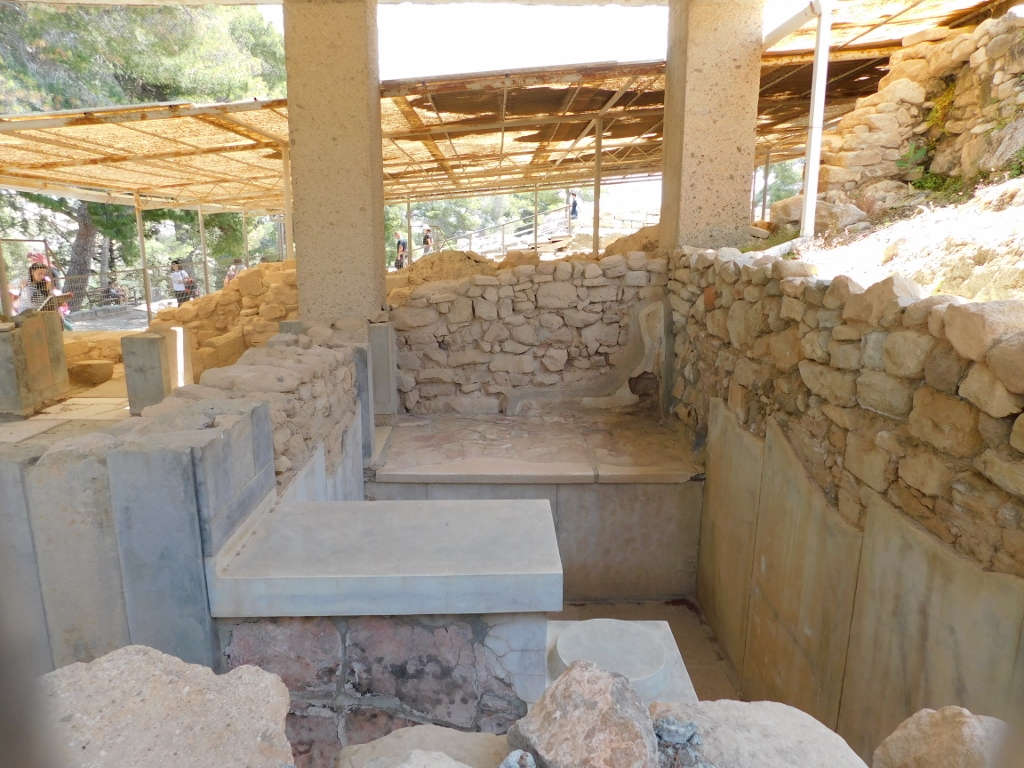 Phaistos: Lustral Basin
Phaistos: Lustral Basin
Here I practically completed my sightseeing of Phaistos, so I first went to the site’s restaurant in order to refresh a little with a cold juice, but along the way I came across a stone sculpture. I absolutely have no idea what this is about, but instantaneously it reminded me of a snake head made of stone that I had seen in Copan, Honduras, and that belongs to the Maya culture, which I have already written about (https://www.svudapodji.com/en/mesoamerica-2008-29/). Here are both of the photos and you can compare them yourselves:
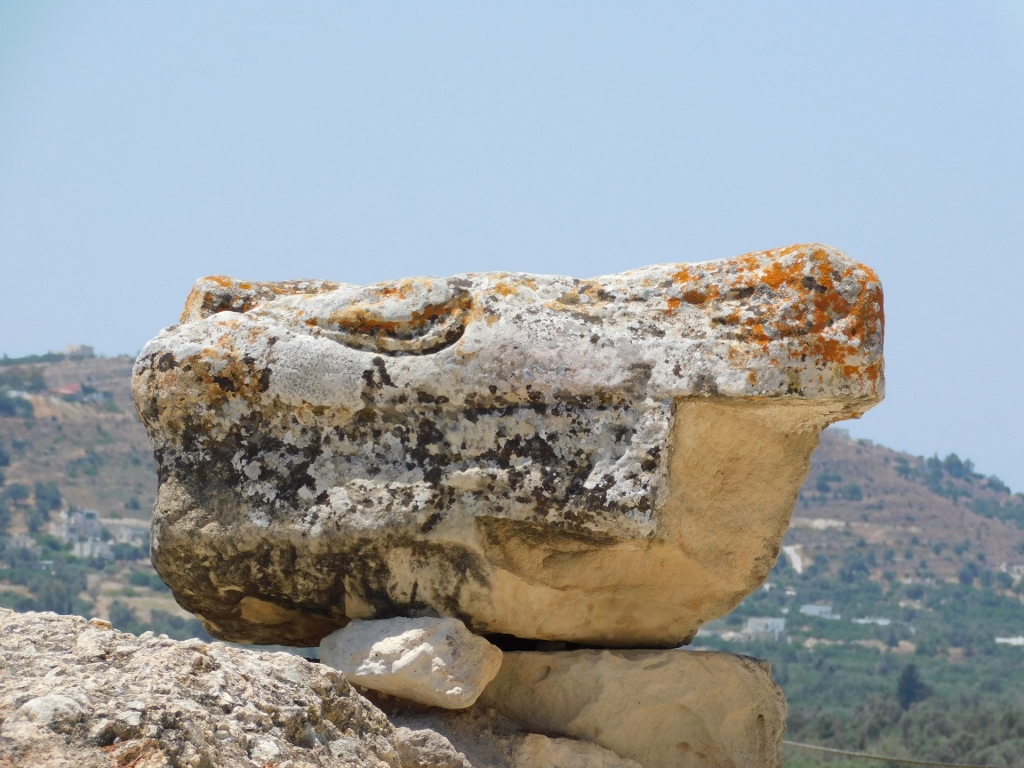 Phaistos: stone sculpture that reminded me of the snake head from Copan
Phaistos: stone sculpture that reminded me of the snake head from Copan
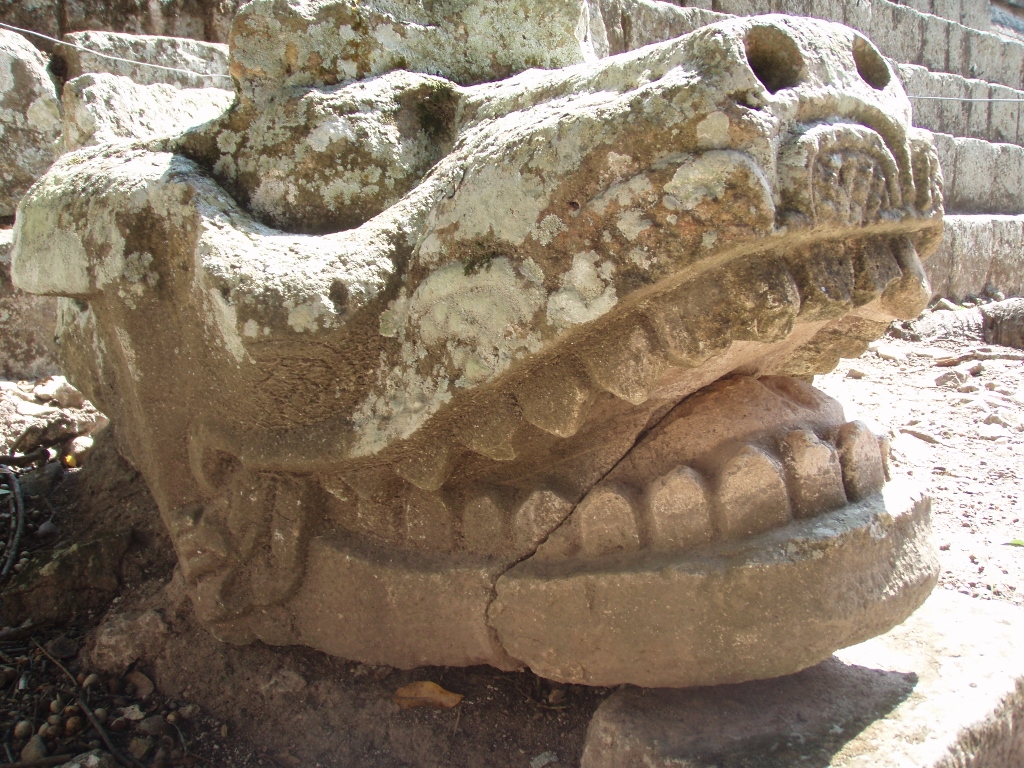 Snake head from Copan, Honduras
Snake head from Copan, Honduras